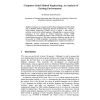Free Online Productivity Tools
i2Speak
i2Symbol
i2OCR
iTex2Img
iWeb2Print
iWeb2Shot
i2Type
iPdf2Split
iPdf2Merge
i2Bopomofo
i2Arabic
i2Style
i2Image
i2PDF
iLatex2Rtf
Sci2ools
CAISE
2008
Springer
2008
Springer
Computer-Aided Method Engineering: An Analysis of Existing Environments
Analogous to Computer-Aided Software Engineering (CASE), which aims to facilitate Software Engineering through specialized tools, ComputerAided Method Engineering (CAME) strives to support a wide range of activities carried out by method engineers. Although there is consensus on the importance of tool support in method engineering, existing CAME environments are incomplete prototypes, each covering just a few steps of the method engineering process. This paper summarizes the history and the state of the practice in CAME technology, and provides criteria-based critique on existing CAME environments, thus highlighting their strengths and weaknesses.
CAISE 2008 | Computer-aided Software Engineering | Information Technology | Method Engineering | Software Engineering |
Related Content
| Added | 08 Nov 2010 |
| Updated | 08 Nov 2010 |
| Type | Conference |
| Year | 2008 |
| Where | CAISE |
| Authors | Ali Niknafs, Raman Ramsin |
Comments (0)

